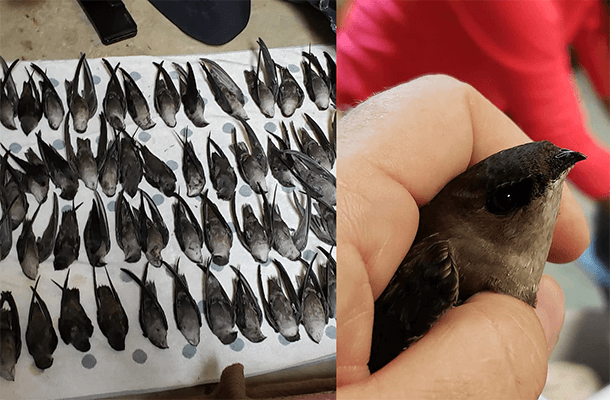Swifts Collide with NASCAR Hall of Fame
Media Contact: Jordan Rutter, Director of Public Relations, 202-888-7472 | jerutter@abcbirds.org
Expert Contact: Dr. Christine Sheppard, Bird Collisions Campaign Director, 646-661-1862 | csheppard@abcbirds.org

Building collisions are a major threat to birds. The incident at the NASCAR Hall of Fame involving hundreds of Chimney Swifts shows just how severe this threat can be. Photo by Carolina Waterfowl Rescue
(Washington, D.C., October 17, 2019) A heart-breaking event occurred Tuesday night, October 15, in Charlotte, North Carolina, when hundreds of Chimney Swifts struck the NASCAR Hall of Fame at full flight speed. This incident, which occurred during bad weather, resulted in 310 bird-window collisions, leaving many birds injured and more than 100 dead, according to Carolina Waterfowl Rescue.
Ordinarily, after sundown, Chimney Swifts would have been sleeping in a sheltered roost. Why they were aloft at night is hard to know, but the building's bright lights likely played a role in attracting them and possibly blinding and disorienting them, leading the flock to collide with windows and walls. The situation in Charlotte is a good illustration of the danger artificial light at night poses to migrants, and recalls a similar episode in Galveston, Texas, in 2017.
As many as 1 billion birds die in collisions with glass (i.e. windows) each year in the U.S. Most of these collisions take place during the day, as migrating birds are looking for food to replenish energy reserves and mistake reflections on glass for habitat.
Buildings pose a particularly serious threat at night and especially when conditions are foggy or stormy, when birds can't see what's below or in front of them. As likely happened with the swifts, a brightly lit building can act as a beacon, one that attracts birds, possibly blinding them at the same time.
“Glass creates dangerous illusions for birds and we must always keep this in mind,” says Dr. Christine Sheppard, American Bird Conservancy's Bird Collisions Campaign Director. “And when light shines through glass at night, this can be an extra-lethal combination.”
“Turning off unnecessary lights can help birds, while saving energy and reducing greenhouse gas emissions,” says Sheppard. “There are simple fixes we can make to reduce the reflective and translucent nature of glass and prevent bird deaths. We should get serious about that.”
American Bird Conservancy wants to help. We invite NASCAR to work with us on efforts to reduce their lighting at night and to retrofit their building's glass to make it bird friendly.
A recent study published in Science reports that the U.S. and Canadian bird population dropped by a net of almost 3 billion birds since 1970. Glass collisions are a major threat to birds, even though there are simple actions that help combat this problem. Basic adjustments to both home and corporate windows can save birds' lives. Get resources and ideas for solutions here.
###
American Bird Conservancy is a nonprofit organization dedicated to conserving birds and their habitats throughout the Americas. With an emphasis on achieving results and working in partnership, we take on the greatest problems facing birds today, innovating and building on rapid advancements in science to halt extinctions, protect habitats, eliminate threats, and build capacity for bird conservation. Find us on abcbirds.org, Facebook, Instagram, and Twitter (@ABCbirds).


















































